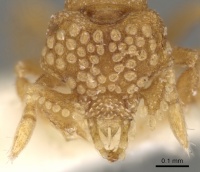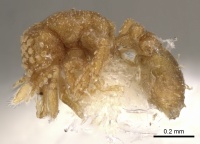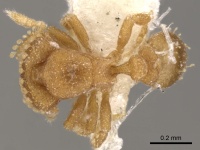Strumigenys tiglath
| Strumigenys tiglath | |
|---|---|

| |
| Scientific classification | |
| Kingdom: | Animalia |
| Phylum: | Arthropoda |
| Class: | Insecta |
| Order: | Hymenoptera |
| Family: | Formicidae |
| Subfamily: | Myrmicinae |
| Tribe: | Attini |
| Genus: | Strumigenys |
| Species: | S. tiglath |
| Binomial name | |
| Strumigenys tiglath (Bolton, 1983) | |
Collected from primary and secondary forest, from the litter and a sample of an Oligomyrmex species.
Identification
Bolton (2000) - A member of the laticeps complex in the Strumigenys argiola group. Apicodorsal mandibular tooth short, not spiniform. Mandible with a single minute preapical denticle located close to the apex. Dorsum of mandible with 2 broad flattened hairs, the proximal of which arises at about the mandible mid-length and the distal of which overhangs the preapical tooth. Anterior clypeal margin with 4 large flat strap-like hairs, the outer pair slightly longer than the broader inner pair; the outers approaching 0.50 X ML. Cephalic orbicular hairs broad, commencing immediately behind the clypeus. With alitrunk in profile dorsal outline of mesonotum not raised posteriorly into a convex hump. See also notes under species-group, Strumigenys marchosias and Strumigenys laticeps.
Bolton (1983) - The closest relative of Strumigenys laticeps is Strumigenys tiglath, which shows most of the characters of laticeps including the 6-segmented antennae, lack of a spiniform tooth dorsally in the apical armament of the mandible, orbicular hairs which occur immediately behind the clypeus and vestigial spongiform appendages on the petiole and postpetiole. Features separating the two species are as follows.
| laticeps | tiglath |
| Larger species with longer mandibles, HW 0.46-0.59, MI 42-48. | Smaller species with shorter mandibles, HW 0.39, MI 35. |
| Dorsal surfaces of mandibular blades lacking large flattened hairs. | Dorsal surfaces of each mandibular blade with two large flattened hairs. |
| Subbasal lobe of scape broad and bluntly rounded. | Subbasal lobe of scape narrow and narrowly rounded. |
| Mesonotum strongly swollen and humped posteriorly. | Mesonotum not swollen, not humped posteriorly. |
Keys including this Species
Distribution
Latitudinal Distribution Pattern
Latitudinal Range: 6.150000095° to 6.150000095°.
| North Temperate |
North Subtropical |
Tropical | South Subtropical |
South Temperate |
- Source: AntMaps
Distribution based on Regional Taxon Lists
Afrotropical Region: Ghana, Ivory Coast (type locality).
Distribution based on AntMaps
Distribution based on AntWeb specimens
Check data from AntWeb
Countries Occupied
| Number of countries occupied by this species based on AntWiki Regional Taxon Lists. In general, fewer countries occupied indicates a narrower range, while more countries indicates a more widespread species. |

|
Estimated Abundance
| Relative abundance based on number of AntMaps records per species (this species within the purple bar). Fewer records (to the left) indicates a less abundant/encountered species while more records (to the right) indicates more abundant/encountered species. |

|
Biology
Castes
Nomenclature
The following information is derived from Barry Bolton's Online Catalogue of the Ants of the World.
- tiglath. Epitritus tiglath Bolton, 1983: 357 (w.) IVORY COAST. Combination in Pyramica: Bolton, 1999: 1672; in Strumigenys: Baroni Urbani & De Andrade, 2007: 129. See also: Bolton, 2000: 292.
Unless otherwise noted the text for the remainder of this section is reported from the publication that includes the original description.
Description
Worker
Holotype. TL 1.4, HL 0.34, HW 0.39, CI 115, ML 0.12, MI 35, SL 0.20, SI 51, PW 0.25, AL 0.38.
Mandibles each with a single minute preapical denticle which is situated very close to the apex and may be obscured by the flattened hairs. Apical mandibular armament consisting of a series of denticles arranged in a more or less vertical row, the basalmost of which appears to be the largest. Without an elongate spiniform tooth at the dorsal end of the series. Two large flattened hairs arise from the dorsal margin of each mandibular blade on their distal halves; the hair closest to the apex is slightly smaller than the one sited nearer the mandibular midlength. Anterior clypeal margin with 4 large spatulate to strap-like hairs which project anteriorly, the outer pair, at the anterolateral angles, is the longest. A pair of much smaller spatulate hairs also projects from the anterior clypeal margin above the mandibular bases and between the larger hairs. Clypeus dully shining and with minute appressed spatulate hairs. Remainder of head reticulate-punctate to granular and densely clothed with large orbicular hairs which occur from immediately behind the posterior clypeal margin to the highest point of the vertex. Antennae with 6 segments, the scapes with a large anteriorly projecting subbasal lobe and fringed around the leading edges with large flattened to spoon-shaped hairs. Outline shape of head capsule as shown for laticeps. Alitrunk in profile with the anterior portion of the mesonotum extremely shallowly concave, the posterior portion very weakly convex just in front of the narrowly incised metanotal groove, the mesonotum not strongly swollen or humped posteriorly. Propodeal dorsum sloping downwards posteriorly, without teeth but the declivity margined on each side by a broad finely spongiform lamella. In dorsal view the pronotum and mesonotum separated by a shallow impression, the mesonotum and propodeum separated by the conspicuous finely incised line of the metanotal groove. Entire alitrunk finely and densely reticulate-punctate, without specialized hairs but the dorsum with stubble-like microscopic erect simple hairs. Petiole node in dorsal view broader than long, bordered posteriorly by a narrow lamellate strip. Postpetiole broader than long, the anterior margin concave, the posterior margin convex and with a distinct median longitudinal impression. The posterior margin of the postpetiole with a narrow lamellate strip, the anterior margin with a short lamellate strip traversing the most concave portion of the border. Ventral surface of petiole with a narrow longitudinal ridge, the postpetiole ventrally without lamellate or spongiform lobes but posterolaterally with a small spongiform appendage. Both petiole and postpetiole reticulate-punctate to granular and equipped dorsally with minute stubble-like hairs such as are seen on the alitrunk. First gastral tergite with straight hairs which are clavate apically, the basigastral costulae short and weak; sculpture of fine reticulation or shagreening. Colour light yellowish brown.
Bolton (2000) - TL 1.3-1.4, HL 0.34-0.36, HW 0.39-0.44, CI 115-122, ML 0.12-0.15, MI 35-40, SL 0.20-0.22, SI 50-51, PW 0.25-0.28, AL 0.38-0.40 (5 measured).
Type Material
Holotype worker, Ivory Coast: Tai Forest, no. 45, 12.viii.1975, in sample of Oligomyrmex sp. (T. Diomande) (The Natural History Museum).
References
- Baroni Urbani, C. & De Andrade, M.L. 2007. The ant tribe Dacetini: limits and constituent genera, with descriptions of new species. Annali del Museo Civico di Storia Naturale “G. Doria”. 99: 1-191.
- Bolton, B. 1983. The Afrotropical dacetine ants (Formicidae). Bulletin of the British Museum (Natural History). Entomology. 46:267-416. (page 357, worker described)
- Bolton, B. 1999. Ant genera of the tribe Dacetonini (Hymenoptera: Formicidae). Journal of Natural History. 33:1639-1689. (page 1672, combination in Pyramica)
- Bolton, B. 2000. The ant tribe Dacetini. Memoirs of the American Entomological Institute. 65:1-1028. (page 292, redescription of worker)
References based on Global Ant Biodiversity Informatics
- Belshaw R., and B. Bolton. 1994. A survey of the leaf litter ant fauna in Ghana, West Africa (Hymenoptera: Formicidae). Journal of Hymenoptera Research 3: 5-16.
- Belshaw R., and B. Bolton. 1994. A survey of the leaf litter ant fauna in Ghana, West Africa (Hymenoptera: Formicidae). Journal of Hymenoptera Research. 3: 5-16.
- Bolton, B. 2000. The Ant Tribe Dacetini. Memoirs of the American Entomological Institute 65
- CSIRO Collection

